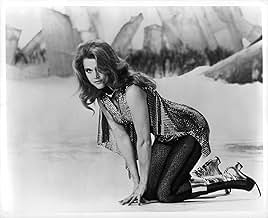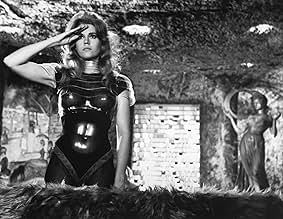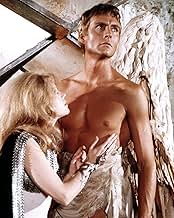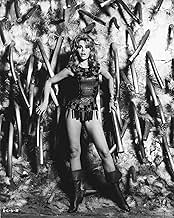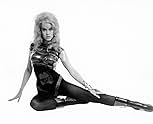पृष्ठभूमि में है 40, 000 साल में ग्रह लिथियन, अंतरिक्ष में यात्रा के दौरान बार्बरेला को मजबूरन उतरना पड़ता है. वह रोबोट और राक्षसों के रूप में बुराई का अंत करती है. अपने साहसिक अभियान में सह... सभी पढ़ेंपृष्ठभूमि में है 40, 000 साल में ग्रह लिथियन, अंतरिक्ष में यात्रा के दौरान बार्बरेला को मजबूरन उतरना पड़ता है. वह रोबोट और राक्षसों के रूप में बुराई का अंत करती है. अपने साहसिक अभियान में सहायता करने वाले सजीले पुरुषों को पुरस्कृत भी करती है.पृष्ठभूमि में है 40, 000 साल में ग्रह लिथियन, अंतरिक्ष में यात्रा के दौरान बार्बरेला को मजबूरन उतरना पड़ता है. वह रोबोट और राक्षसों के रूप में बुराई का अंत करती है. अपने साहसिक अभियान में सहायता करने वाले सजीले पुरुषों को पुरस्कृत भी करती है.
- पुरस्कार
- कुल 1 नामांकन
- Captain Moon
- (as Veronique Vendell)
- The Suicide
- (काटे गए सीन)
- (as Franco Gula)
- Bald Handmaiden at Sogovian Court
- (बिना क्रेडिट के)
- Girl in Sogo
- (बिना क्रेडिट के)
फ़ीचर्ड समीक्षाएं
On her quest she finds daunting foes, unexpected comrades and twists and turns like any good superhero story should have. The only problem is that her world is made up of Christmas lights, cellophane and balsa wood, and it's all held together with scotch tape.
However what some might consider schlock entertainment, I saw it as pure camp all the way, with some hysterical situations and outrageous costumes draped over not-so-difficult-to-look-at actors (especially our babe-o-naught Ms. Fonda), and to top off the cake we have an icing of infectious music by comedic composer Charles Fox (9 to 5, Foul Play) and singer/songwriter Bob Crewe.
This is pure candy all the way so don't expect any nutrition here, but if you let it happen instead of looking for more, you may find yourself inspired to watch it again and again, when you don't feel like using any brain cells in this dimension.
The opening striptease by Jane (with the opening credits moved around to help obscure her nudity) may play a pivotal part in why this is so beloved as a cult classic 50 years later. But in truth, this off the wall science fiction tale is plenty goofy, enough so that the movie does have a real sense of fun going for it. It amps up its sex appeal and its psychedelic qualities to the nth degree, and its production design (by Mario Garbuglia) and cinematography (by Claude Renoir) are first-rate. Along with amusing special effects, this results in a non-stop assortment of futuristic and exotic eye candy. Based on a best-seller by Jean-Claude Forest, the script (bearing contributions by EIGHT credited individuals) contains some endearingly literate but silly dialogue.
Jane is appealing, playing a character who is not all that heroic; she needs saving more than once, and often must rely on the help of others. Her wide-eyed innocence (and that of the likeable hunk Law) is contrasted by the lascivious qualities of the production and the delicious villainy of the characters played by Pallenberg and O'Shea. (Trivia note: a certain 80s rock band took its name from the name of O'Sheas' character.) Memorable contributions are also made by Marcel Marceau, David Hemmings (very funny as a comedy-relief revolutionary), and Ugo Tognazzi.
Complete with a catchy, groovy score and songs (by Charles Fox and Bob Crewe), and Roger Vadim (Janes' husband at the time) directs with great style.
Overall, quite engaging, although clearly not something to be taken seriously.
Seven out of 10.
I first saw the film at university in the early eighties when a student film society organised a screening. Interest in it at that time may have been aroused by the release in 1980 of "Flash Gordon", another ultra-camp science fiction film which was undoubtedly influenced by it, and by the fact that one of the leading British pop groups of the era had called themselves Duran Duran in homage to their origins in a now-defunct Birmingham nightclub called Barbarella's.
The film is based on a French series of comic books, which I must admit I have never read. (Unlike, say, the "Asterix" or "Tintin" series, the Barbarella comics have never had much of a following in Britain). The action takes place in the 40th century. Barbarella, a beautiful young female astronaut, is ordered by the President of Earth to travel to the planet Tau Ceti to find a scientist named Durand Durand, from whom the band took their misspelled name. Durand is the inventor of a weapon known as the Positronic Ray, which the President fears may fall into the wrong hands.
The rest of the film is taken up with Barbarella's increasingly bizarre adventures on Tau Ceti. She goes ice-skiing across the planet's frozen surface, pulled along by an octopus-like creature, is menaced by flesh-eating dolls with razor-sharp teeth, seduces a blind angel (or "ornithanthrope"), meets the predatory lesbian Queen of a decadent city and survives an attempted execution by means of an "orgasmatron", a machine designed to kill by an excess of sexual pleasure. (Barbarella's capacity for sexual pleasure is so great that she blows its circuits). We are not, of course, meant to take any of this seriously; the whole thing is intended as a sort of tongue-in-cheek exercise in high camp surrealism, Salvador Dali meets Edna Everage. The surreal nature of the film is emphasised by the use of psychedelic lighting effects. (The opening song even includes the rhyme "Barbarella Psychedella").
Barbarella is played by Jane Fonda, who at the time was married to the director Roger Vadim, clearly a man with the knack of attracting beautiful women. (He had previously been married to Brigitte Bardot and had been the lover of Catherine Deneuve). I wonder if, when Fonda was taking her wedding vows, she realised that Vadim's interpretation of "for better or for worse" included casting his wife in eccentric films like this one. Her devotion to her wifely duties seems to have been at the expense of her career; she later revealed that her commitment to "Barbarella" meant having to turn down the leading roles in two more serious films, "Bonnie and Clyde" and "Rosemary's Baby". Moreover, many of the heroine's adventures seem to have been designed with the express purpose of showing off Fonda's figure in a series of provocative outfits, leaving her with a lasting "sex kitten" image. This was something she was never comfortable with, especially when she was trying to reinvent herself as a feminist and left-wing activist a few years later.
This is far from being Fonda's best film, yet she is about the only cast member who emerges with any credit from it, playing the heroine as a sort of wide-eyed innocent abroad. John Phillip Law, who plays the ornithanthrope Pygar, is so wooden that I wondered if he was under instructions to play his role with a deliberately deadpan lack of emotion. David Hemmings as the resistance leader Dildano shows us just why his career never really took off in the way it was expected to after his early breakthrough in "Blowup". (Hemmings's costume, looking like a pair of leather Y-fronts, is just as bizarre as anything worn by Fonda). Marcel Marceau shows that his talents as a mime did not extend to acting in spoken roles. Anita Pallenberg, better known for her relationships with several members of the Rolling Stones, was cast as the wicked Queen, but Vadim did not trust her to speak her own lines; the Queen speaks with the unmistakable contralto tones of Joan Greenwood.
"Barbarella" was a failure on its release, both at the box office and with the critics, yet despite the dodgy acting and the nonsensical plot it has since 1968 acquired the status of a cult movie. (Even back in my student days it was regarded as sort of historic artifact). Cults, whether religious or cinematic, can be baffling to everyone except ardent devotees, yet I must confess that I have a soft spot for this surreal relic of the hippie era. It is an ideal film to watch when returning from the pub late at night. Particularly if one is drunk. 6/10
क्या आपको पता है
- ट्रिवियाThe scenes during the opening credits where Barbarella seems to float around her spaceship were filmed by having Jane Fonda lie on a huge piece of Plexiglas with a picture of the spaceship underneath her. It was filmed from above, creating the illusion that she is in zero gravity.
- गूफ़It is established that Barbarella needs a Tongue Box, a device attached to the bracelet she wears on her left wrist, to understand the spoken language of Sogo. Barbarella loses the bracelet after the Excessive Machine scene, but she still understands the Great Tyrant, Pygar, and the Sogoites speaking through the Tyrant's monitor.
- भाव
Barbarella: What's that screaming? A good many dramatic situations begin with screaming...
- क्रेज़ी क्रेडिटIn the opening credits, the letters in the words move around in an attempt to obscure Barbarella's nudity.
- इसके अलावा अन्य वर्जनBarbarella was released in the USA before the MPAA introduced the motion picture rating system on November 1, 1968. It was consequently released with a tag "Suggested For Mature Audiences". A re-release in 1977 (to cash in on the success of स्टार वॉर्स (1977)) was edited to obtain a "PG" rating and was called "Barbarella: Queen Of The Galaxy". The video version is of the original uncut version and not the "PG" version (despite the subtitle "Queen of the Galaxy" and the "PG" rating on the cover).
- कनेक्शनEdited into Duran Duran: Burning the Ground (1989)
टॉप पसंद
- How long is Barbarella?Alexa द्वारा संचालित
- Was Barbarella a virgin before meeting the Fur Trapper?
विवरण
- रिलीज़ की तारीख़
- कंट्री ऑफ़ ओरिजिन
- भाषाएं
- इस रूप में भी जाना जाता है
- Barbarella: Queen of the Galaxy
- फ़िल्माने की जगहें
- उत्पादन कंपनियां
- IMDbPro पर और कंपनी क्रेडिट देखें
बॉक्स ऑफ़िस
- बजट
- $90,00,000(अनुमानित)
- दुनिया भर में सकल
- $1,622
- चलने की अवधि1 घंटा 38 मिनट
- रंग
- पक्ष अनुपात
- 2.35 : 1
इस पेज में योगदान दें




